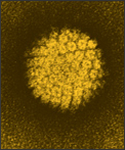Darlene* is 30 years old, about to start her dream job, and thinks her current boyfriend, Daniel, might be “the one.” She has wanted kids forever, and is optimistic that if the relationship progresses as she thinks this will, he will be the perfect partner with which to raise the family she has longed for for as long as she can remember. She requests some short-term contraception, as she’d like to get more firmly established at work, and have time to put aside money to buy the cute ranch with the picture windows out front that she and Daniel found while browsing on Zillow. Hopefully, in the not too distant future, they’ll be ready to start the family she has visualized in her mind thousands of times. Her last pap smear was a couple of years ago, she’s been so busy with work, and life, but her paps have always been normal. She figures the doc will do one at her birth control visit, and she can check it off of her to do list. Her parents decided against having her receive the human papilloma virus (HPV) vaccine when it came out in 2006, when she was 12, because it was “new”, and they wanted to “wait and see,” unpersuaded by studies which showed that it significantly reduced the risks of genital wart infections and pre-cancerous and cancerous changes of the cervix. Over the years, Darlene’s pediatrician, and then her gynecologist, encouraged her to get the HPV vaccine. However, she felt that since she was selective about her boyfriends, had made it this far without any adverse consequences, and it would entail several copays to complete the 3-vaccine series, she’d pass. After all, she reasoned, that cute ranch was a more tangible and satisfactory use for her money. A week later, she was flabbergasted when her doctor called to say that her pap showed high grade squamous intraepithelial lesion (HGSIL for short), formerly known as moderate or severe dysplasia. Her doctor explained that this diagnosis has up to a 30% risk of turning into cervical cancer over 30 years if left untreated. Fortunately, treatment is usually successful, but she would need to come in for a colposcopy, or microscopic examination of her cervix and vagina, to see where the abnormal cells were located, and to have biopsies to determine if the abnormality found on the pap screening accurately reflected the situation. If so, she would need treatment with either freezing, laser vaporization, or an excisional procedure. Her doctor reassured her again that treatment was usually successful, but did explain that some of the treatment options might increase her risk of pre-term labor and delivery, and her risk of recurrent abnormal cells would last for decades.
Gardasil-9, one of the 2 main HPV vaccines, is designed to protect against 9 sub-types of HPV. 2 of these subtypes, 6 and 11, are responsible for more than 85% of the cases of genital warts. Subtypes 16 and 18 are responsible for the majority of cases of cervical cancer, as well as large numbers of anal, oropharyngeal (throat/larynx), vulvar, penile, and vaginal cancers. Gardasil 9 also produces antibodies, or an immune response, to HPV subtypes 31/33/45/52/58, and may prevent an additional 4-18% of cancers beyond Gardasil-4, the original quadrivalent vaccine (6/11/16/18). The vaccine is extremely safe, with the most common side effects being pain, redness, or swelling at the injection site. It is approved for use in males and females from ages 9-45. Overall, Gardasil 9 has been shown to prevent 88% of persistent HPV infections of the cervix, vagina, vulva attributable to the HPV subtypes targeted by the vaccine. According to the CDC, it is estimated to prevent over 90% of HPV associated cancers. If Darlene had gotten the HPV vaccine prior to becoming sexually active, she most likely could have avoided the anxiety, stress, cost, time, and risks involved in the evaluation and treatment associated with her abnormal pap smear.
Sadly, Darlene’s situation is not unusual. As of 2019, only 54.4% of US teens aged 13-17 were up to date on their HPV vaccinations. Vaccination completion rates in this category were highest in Asians, at 64.7%, and lowest in Whites at 51.6%, with Blacks (54.3%) and Hispanics (58.1%) in the middle.
There are a number of reasons why parents, and vaccine candidates themselves choose not to receive the vaccine. They may be worried that there isn’t enough evidence to support its use, fear of unknown consequences, assumptions that the vaccine will incentivize sexual activity, lack of knowledge, lack of access, incorrect perception of disease risk, and cost. The facts are that the benefits far outweigh the risks, vaccination does not increase the likelihood of sexual activity, there is financial assistance available thru the Vaccines for Children Program for eligible patients not covered by government, military, or private insurance, and the risk of disease is very real. One in 4 people are currently infected with HPV in the US and it is estimated that 80% of sexually active people will have HPV at some point in their lives. The HPV vaccine typically entails 2 doses if given between the ages of 9 and 14, and 3 doses between ages 15-45. It is far better to live in a world where we can prevent disease than one in which we have no options. Isn’t a couple of shots worth it?
For more information: https://www.cdc.gov/vaccines/vpd/hpv/public/index.html
*Names and details have been changed for patient privacy, and may represent amalgamations of people and events

